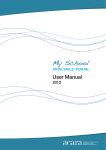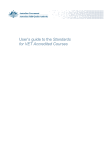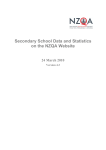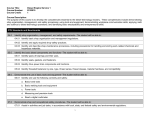Download AURTTA2001 Identify basic automotive faults using troubleshooting
Transcript
AURTTA2001 Identify basic automotive faults using troubleshooting processes AURTTA2001 Identify basic automotive faults using troubleshooting processes Unit descriptor This unit describes the performance outcomes required to conduct troubleshooting processes to identify common automotive faults or problems based on evidence provided by customers. Licencing, legislative, regulatory or certification requirements may apply to this unit in some jurisdictions. Users are advised to check with the relevant regulatory authority. This unit contains employability skills. Employability skills Prerequisite units Co-requisite units Application of the unit Competency field Unit sector Work applies to the identification of basic automotive faults of motorcycles, light vehicles, heavy commercial vehicles, agricultural equipment, mobile plant and other industrial environments. Mechanical Miscellaneous Technical ELEMENT PERFORMANCE CRITERIA Elements describe the essential outcomes of a unit of competency. Performance criteria describe the required performance needed to demonstrate achievement of the element. Where bold italicised text is used, further information is detailed in the required skills and knowledge and/or the range statement. Assessment of performance is to be consistent with the evidence guide. 1. Identify nature of the fault or problem 2. Identify fault using troubleshooting processes 3. Clean up work area and finalise work processes 1.1. Questioning techniques are applied to determine nature of the customer enquiry 1.2. Occupational Health and Safety (OHS) requirements are observed and applied throughout the work 1.3. Information relating to the fault or problem is gathered, documented and confirmed with customer 1.4. Troubleshooting process options are researched and those most appropriate to the circumstances are selected 2.1. Automotive system or component relating to the fault or problem is identified 2.2. Troubleshooting processes are performed according to workplace procedures and without causing damage to components or systems to identify the likely cause of the fault or problem 2.3. Report is forwarded to persons for action according to workplace procedures 3.1. Final inspection is made to ensure work is to workplace expectations 3.2. Tools and equipment are checked and stored according to workplace expectations REQUIRED SKILLS AND KNOWLEDGE This section describes the skills and knowledge required for this unit. Required skills communication skills to follow oral and written instructions learning skills to identify sources of information, assistance and expert knowledge to expand knowledge, skills and understanding literacy skills to: o read, interpret and follow information on written job instructions, specifications, standard operating procedures, charts, lists, drawings and other applicable reference documents o follow workplace documentation, such as codes of practice or operating procedures o document work performed during troubleshooting operations Auto Skills Australia AUR12 v0.1 Page 1 of 3 AURTTA2001 Identify basic automotive faults using troubleshooting processes REQUIRED SKILLS AND KNOWLEDGE planning and organising skills to ensure tasks are completed within an acceptable timeframe o problem-solving skills to seek information and assistance as required to solve problems self-management skills to: ◦ select and use appropriate equipment, materials, processes and procedures ◦ follow workplace documentation, such as codes of practice or operating procedures teamwork skills to apply knowledge of own role to complete activities efficiently to support team activities and tasks ◦ technology skills to use technology to collect and provide information. Required knowledge WHS regulations, requirements, equipment and material, and personal safety requirements identification of basic automotive systems basic troubleshooting techniques/processes, including: ◦ customer questioning skills to identify vehicle system in which fault lies ◦ use of simple diagnostic charts procedures for reporting and documenting findings RANGE STATEMENT The range statement relates to the unit of competency as a whole. It allows for different work environments and situations that may affect performance. Bold italicised wording, in the performance criteria, is detailed below. Essential operating conditions that may be present with training and assessment (depending on the work situation, needs of the candidate, accessibility of the item, and local industry and regional contexts) may also be included. Questioning techniques may include: Workplace health and safety (WHS) requirements: Troubleshooting process options may include: Faults: open and closed questions funnel, probing and leading questions. are those prescribed under legislation, regulations, codes of practice, and workplace policies and procedures may include: ◦ protective clothing and equipment ◦ use of tools and equipment ◦ handling of material ◦ use of fire-fighting equipment ◦ first aid equipment hazard control, including control of hazardous materials and toxic substances. analysis of available information to provide a list of tests to perform use of diagnostic flowcharts are basic in their scope may include: ◦ lighting steering, suspension, braking, engine, drivetrain or fuel system faults EVIDENCE GUIDE The evidence guide provides advice on assessment and must be read in conjunction with the Performance Criteria, required Skills and Knowledge, the Range Statement and the Assessment Guidelines for the Training Package. Overview of assessment Critical aspects for assessment and evidence required to demonstrate competency in this unit Auto Skills Australia AUR12 v0.1 The evidence required to demonstrate competency in this unit must be relevant to workplace operations and satisfy all of the requirements of the performance criteria and required skills and knowledge. A person who demonstrates competency in this unit must be able to: Page 2 of 3 AURTTA2001 Identify basic automotive faults using troubleshooting processes EVIDENCE GUIDE Context of, and specific resources for assessment Method of assessment Auto Skills Australia AUR12 v0.1 observe safety procedures and requirements communicate effectively with others involved in or affected by the work select methods and techniques appropriate to the circumstances identify a range of basic automotive faults conduct troubleshooting procedures according to workplace and manufacturer/component supplier requirements complete workplace documentation according to workplace requirements. Competency is to be assessed in the workplace or a simulated workplace environment that accurately reflects performance in a real workplace setting. Assessment is to occur: using standard workplace practices and procedures following safety requirements applying environmental constraints. Assessment is to comply with relevant: regulatory requirements Australian standards industry codes of practice. The following resources must be made available for the assessment of this unit: workplace location or simulated workplace vehicles/equipment with basic faults relevant to the qualification being sought equipment appropriate for the troubleshooting of basic automotive faults specifications and workplace instructions. Assessment must satisfy the endorsed Assessment Guidelines of this Training Package. Assessment methods must confirm consistency and accuracy of performance (over time and in a range of workplace relevant contexts) together with the application of required skills and knowledge. Assessment methods must be by direct observation of tasks and include questioning on required skills and knowledge to ensure correct interpretation and application. Competence in this unit may be assessed in conjunction with other units which together form part of a holistic work role. Where applicable, reasonable adjustment must be made to work environments and training situations to accommodate the needs of diverse clients. Assessment processes and techniques must be culturally sensitive and appropriate to the language, literacy and numeracy capacity of the candidate and the work being performed. Page 3 of 3










